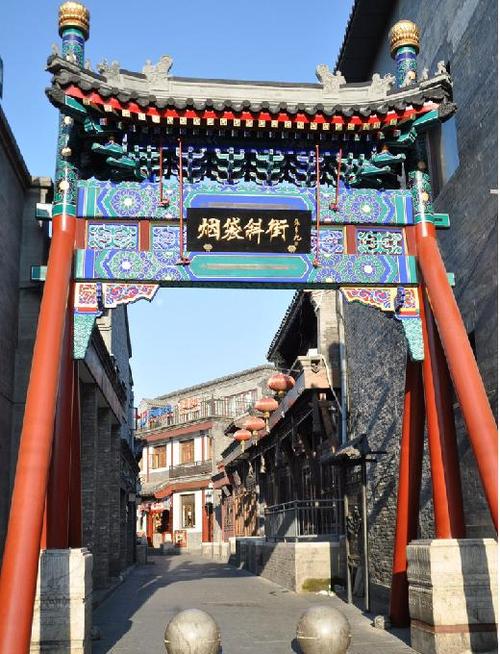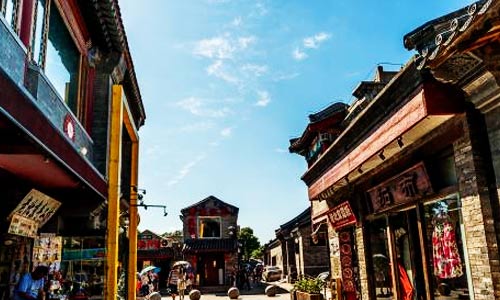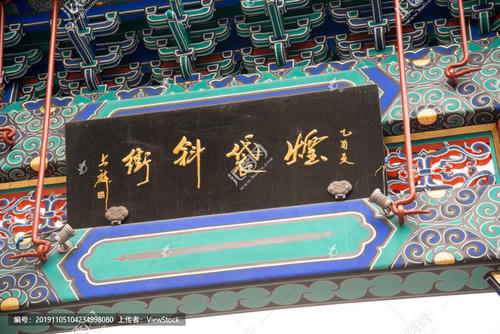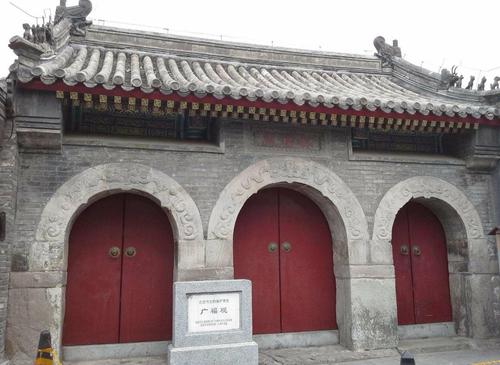Chinese Name: 烟袋斜街 Pronunciation: Yāndài Xiéjiē
Length: 232 meters
Building Time: The Yuan Dynasty (1271-1368)
Recommended Visiting Time: 2 Hours
Address: No. 50, Di’anmen Outer Street, Xicheng District, Beijing, China
Building Function: It is a good place to look for delicious food, collect antiques and appreciate calligraphy, paintings, and ancient buildings.

Yandaixie Street, about 400 meters from the Drum Tower, is located in Di’anmen Outer Street, Xicheng District, Beijing. Its architectural style of stores is simple and bears the characteristics of old Beijing City. Yandaixie Street is a famous cultural street in Beijing.
Yandaixie Street, as famous as the Drum Tower, the South Luogu Lane, and other well-known scenic spots in Beijing, is a good place for everyone to spend their leisure time looking for food, collecting antiques, and appreciating calligraphy, paintings, and ancient buildings.
Located in the core area of the Shichahai Historical and Cultural Protection Area, Yandaixie Street starts from Di’anmen Street in the east and is adjacent to Shichahai in the west. It runs from northeast to southwest, with a total length of 232 meters and a width of 5 to 6 meters. In 2007 the street was listed as one of the eight distinctive commercial streets to be constructed.
About 40 meters into the eastern entrance of Yandaixie Street, the foundations of buildings are 1.4 meters higher than the ground, so the stores in the eastern entrance have high steps. In the northwest of the street that is the southern entrance of Dashibei Hutong, the foundations of buildings are higher than the road surface by 50 centimeters. The road surface forms a gentle slope, indicating that the formation of Yandaixie Street is related to the change of the riverbank of Shichahai.

After the renovation of Yandaixie Street, the buildings on both sides are simple but elegant with the eye-catching architectural style of the Ming and Qing Dynasties. The architectural style “imperial court as the former part and the market as the latter part” represents the marketplace style and the characteristics of old Beijing City.
The street is like a time tunnel, into which you can see many visitors in fashionable and bright clothes, with different skin colors and in various languages, looking for all kinds of toys or accessories. Suddenly, you have a feeling of not knowing where you are and what era you are in. In fact, Yandaixie Street is not only an old commercial street in Beijing but also an old cultural street.
Yandaixie Street was awarded the title of “Chinese Historical and Cultural Street” by the Ministry of Culture and the National Cultural Heritage Administration on November 10, 2010. As the second project to be awarded this title after Guozijian, the national central institution of higher learning in the past dynasties, Yandaixie Street is built for being a commercial tourism street featuring Beijing folklore culture.
Experts hold that the reason why Yandaixie Street was selected as “Chinese Historical and Cultural Street” is that its basic architectural style has remained and the residents there have inherited the lifestyle from the past. Meanwhile, the protection work of this historical street with rich culture and urban memory has achieved milestone results.

Yandaixie Street was built in the Yuan Dynasty (1271-1368), and the form of the street has direct relevance to the transportation of grain and goods in the Tonghui River. The prosperity of Yandaixie Street originated in the Gulou West Street. Kublai Khan, the founder of the Yuan Dynasty, asked to build the capital with the layout of “the imperial court as the former part and the market as the latter part”. In other words, the imperial court ranged from Yongding Gate to the three halls (the Hall of Supreme Harmony, the Hall of Central Harmony, and the Hall of Preserving Harmony), and the market was behind the Bell Tower and the Drum Tower.
Due to the excavation of the Tonghui River to the Grand Canal, the southern cargo ships could directly dock at the capital, so that a variety of goods were continuously supplied to the market. After the completion of the Tonghui River, Jishuitan became a dock. Cargo ships carrying rice, tea, and other commodities arrived in Beijing continuously, and many shops were established. To provide a passageway from the dock to the front of the Drum Tower, the sloping street was built between Jishuitan and the Drum Tower.
From the perspective of layout, the construction of the capital city in the Yuan Dynasty was a pioneering initiative in the history of world architecture. The capital city was rectangular, with wide, straight, and orderly streets. There were nine main lines in the east-west and south-north directions respectively. Only the line from Desheng Gate to the Drum Tower was slanting. However, this slanting street was very practical and helpful, which partly solved traffic problems and shortened the distance. Therefore, the street was not only the earliest slanting street in Beijing but also the key passage of transportation and trade in this area at that time.

In the Ming Dynasty (1368-1644), the city center moved southward, and the waterway of the Tonghui River began to be silted up and blocked so that cargo ships could no longer enter the Jishuitan Dock. The slanting street also moved southward, and the bustling center of the city became the area around Yandaixie Street. Such changes laid the most important cornerstone for the prosperity of Yandaixie Street in the Qing Dynasty and the Republic of China.
In the Qing Dynasty (1636-1912), many officials, soldiers, and civilians had the habit of smoking. As a result, tobacco shops flourished. Yandaixie Street was booming during the reign(1875-1908) of Emperor Guangxu in the Qing Dynasty, and the name of Yandaixie Street was also called in this period. What is more, all kinds of shops emerged, such as restaurants, tobacco shops, teahouses, shops specializing in smoking sets, and so on.

Guangfu Daoist Temple, Located in the middle section of Yandaixie Street, Guangfu Daoist Temple (Guangfu Guan) was built in 1459 during the Ming Dynasty. During the reign(1723-1735) of Emperor Yongzheng in the Qing Dynasty, it was rebuilt and renamed Fuyou Gong. In the ninth year (1883) of Guangxu’s reign in the Qing Dynasty, its gate was rebuilt.
During the period of the Republic of China, it was called Guangfu Guan again. In 2007, with the promotion of building Yandaixie Street, a distinctive commercial street, Guangfu Guan began to be renovated. In 2008 it was reopened to the public.

There are a great number of featured stores on Yandaixie Street. Visitors can buy many souvenirs and novelties, such as accessories, tobacco pipes, silk scarves, Chinese minority costumes, etc. The street is a good place to experience Chinese traditional commercial culture, and visitors can have fun bargaining with shop owners, which would be a rather interesting thing.

There are also plenty of restaurants along Yandaixie Street, such as Meiyuan Dairy, Yao Ji Stewed Liver, Daoxiangcun (a famous shop that mainly sells cakes, cookies, quick-frozen food, and other special food), and so on.
Visitors can experience the charm of the Intangible Cultural Heritage there, including paper-cutting, sugar-figure blowing, and clay-figure making. If you are interested in such handicrafts, you can try to blow a sugar figure by yourself.
After visiting Yandaixie Street, visitors can also go to the nearby scenic spots, such as Houhai Lake, Prince Gong’s Mansion, Lotus Market, and Jingshan Park. Tourists can choose the way to visit, either on foot or by bicycle.
Take bus 5, 60, 107, 124, or 635 and get off at Drum Tower Station, and then walk about 140 meters along the Di’anmen Outer Street to Yandaixie Street.
Take Metro Line 8, get off at Shichahai Station and exit A2, and then walk about 90 meters along the Wannian Hutong, turn right, walk about 50 meters to Yandaixie Street.
Chinese: 请带我去烟袋斜街。English: Please take me to Yandaixie Street.
If you go to Yandaixie Street from the center of Beijing (Grand Hyatt Beijing), it takes about 20 minutes (about 20 yuan).
If you go to Yandaixie Street from Beijing Capital International Airport, it takes about 45 minutes (about 80 yuan).
If you go to Yandaixie Street from Beijing Daxing International Airport, it takes about 80 minutes (about 200 yuan).
If you go to Yandaixie Street from Beijing West Railway Station, it takes about 30 minutes (about 40 yuan).
